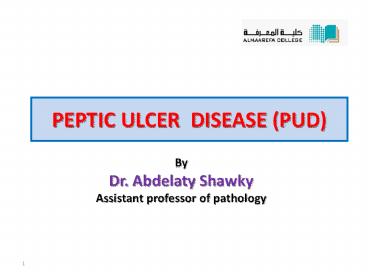PEPTIC ULCER DISEASE (PUD) - PowerPoint PPT Presentation
Title:
PEPTIC ULCER DISEASE (PUD)
Description:
PEPTIC ULCER DISEASE (PUD) By Dr. Abdelaty Shawky Assistant professor of pathology * Ulcer is defined as a breach in the mucosa , which extends through the muscularis ... – PowerPoint PPT presentation
Number of Views:644
Avg rating:3.0/5.0
Title: PEPTIC ULCER DISEASE (PUD)
1
PEPTIC ULCER DISEASE (PUD)
- By
- Dr. Abdelaty Shawky
- Assistant professor of pathology
2
- Ulcer is defined as a breach in the mucosa ,
which extends through the muscularis mucosa into
the submucosa or deeper. - Erosion differs from an ulcer in being more
superficial and partially affecting the surface
epithelium).
3
Definition of peptic ulcer
- Peptic ulcers are chronic most often solitary,
lesions that occur in any portion of the
gastrointestinal tract exposed to the aggressive
action of acidic-peptic secretion.
4
Sites of peptic ulcer
- Duodenum (DU) First portion. Anterior wall is
more often affected. - Stomach (GU) Usually antrum. Lesser curvature
(common) . - At the margins of a gastroenterostomy (stomal
ulcer) - In the duodenum, stomach or jejunum of patients
with Zollinger-Ellison syndrome. - Within Meckels diverticulum that contains
ectopic gastric mucosa.
5
Pathogenesis of peptic ulcer
- Peptic ulcers are produced by an imbalance
between the gastro-duodenal mucosal defense
mechanisms and damaging forces.
6
(No Transcript)
7
Mucosal defense mechanisms
- Surface mucous secretion.
- Bicarbonate secretion into mucous.
- Tight adherence between epithelial cells to
prevent any acid leakage to the inside. - Good blood supply to the mucosa
- Renewal of damaged epithelial cells.
- Elaboration of prostaglandins.
8
Damaging agents
- H. pylori
- NSAIDs.
- Aspirin.
- Cigarette smoking.
- Alcoholism.
- Gastric hyperacidity.
- Duodenal-gastric reflux..
9
Role of H. Pylori infection in the pathogenesis
of peptic ulcer
- H. pylori infection is present in almost all
patients with duodenal ulcers and 70 of cases
with gastric ulcers. - Mechanism
- H. pylori secretes damaging enzymes
- Urease breaks down urea to toxic compounds e.g.
ammonium chloride. - Protease breaks down glycoprotein in the gastric
mucus). - Phospholipases. Damage the cell membranes of
surface epithelial cells.
10
- 2. Bacterial lipopolysaccharide stimulate the
surface epithelial cells to release
pro-inflammatory cytokines e.g. IL-1, IL-6 and
TNF. These attracts inflammatory cells
(Neutrophils) to the mucosa and promote the
inflammatory reaction - 3. H. pylori release bacterial platelet-activating
factor promotes thrombotic occlusion of surface
capillaries.
11
- 4. H. pylori enhances gastric acid secretion and
impairs duodenal bicarbonate production, thus
reducing luminal pH in the duodenum. This altered
milieu seems to favor gastric metaplasia (the
presence of gastric epithelium) in the first part
of the duodenum. - - Such metaplastic foci provide areas for H.
pylori colonization.
12
(No Transcript)
13
Gross features
- Site Gastric ulcers are located at the antrum
toward the lesser curvature. The duodenal ulcer
is usually located at the 1st part anteriorly. - Shape Round, oval.
- Size Usually less than 2cm in diameter.
- Lesions less than 0.3 cm are likely to be
shallow erosions. - Giant ulcers are usually greater than 3cm in
diameter. - Size does not differentiate benign from malignant
ulcer.
14
- Base of ulcer
- Firm (formed of bundles of muscles and fibrous
tissue). - Floor
- Clean (gastric juice digest any food particles at
the floor. - Margin (Surrounding gastric mucosa)
- Edematous and reddened due to gastritis.
- Depth of the ulcer
- Superficial ulcer penetrate the mucosa reaching
up to the muscularis mucosa. - Deeply excavated ulcers having their bases on
the muscularis propria.
15
GU
16
Gastric ulcer
17
Duodenal ulcer
18
Microscopic features
- - Four distinct layers are present in a peptic
ulcer in the same sequence starting from the
luminal side - 1. Necrotic debris.
- 2. Non-specific acute inflammatory reaction.
- 3. Granulation tissue.
- 4. Fibrosis replacing the muscle wall and
extending into subserosa.
19
Microscopic picture of peptic ulcer
20
Complications of PUD
- 1. Hemorrhage hematemesis or melena.
- 2. Perforation.
- 3. Healing by fibrosis causing obstruction.
- 4. Malignant transformation rare (0.5 of
gastric peptic ulcer).
21
Clinical presentation
- A chronic, recurring lesion.
- Age Most often diagnosed in middle aged to older
adults. - Pain
- - Epigastric burning or aching pain.
- Pain worse at night and 1 to 3 hours after meal
during the day specially in duodenal ulcer. - Classically, the pain is relieved by alkalis or
food (DU) or vomiting (GU).
22
- Nausea, vomiting, bloating, and significant
weight loss (raising the possibility of some
hidden malignancy) are additional manifestations.
- With penetrating ulcers, the pain is occasionally
referred to the back, the left upper quadrant, or
chest. This type of pain may be misinterpreted as
being of cardiac origin.
23
Thanks
References Robbins and Cotrans Pathologic
Basis of Disease. Seventh edition.

